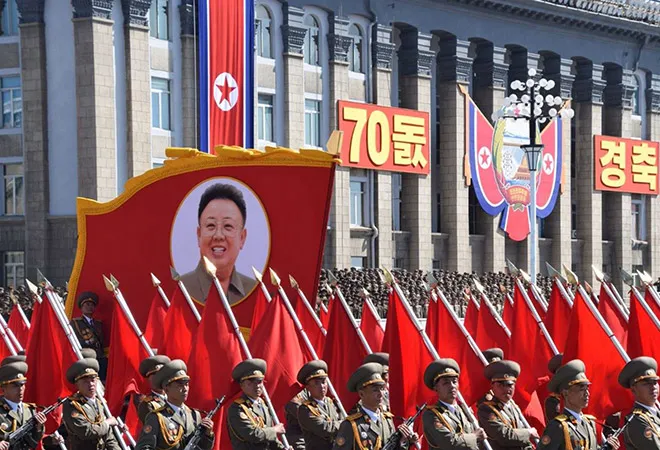
The rogue half of the Korean Peninsula, North Korea, is infamous for its military strength and nuclear weapons. If the
blitzkrieg of missile testing in 2022 was not enough, the annual showcase of its military poses a threat to not only South Korea but also the United States (US). Democratic People’s Republic of Korea (DPRK) annually showcases its military power through a military parade. The recent parade on the dawn of 8th February 2023 marked the official 75th founding anniversary of the Korean People's Army (KPA). Pyongyang was reportedly preparing for a massive military parade with
13,000 North Korean soldiers have been practising in the bitter cold for months. The article will shed light on the military show and the threat it poses to South Korea, followed by the need for a hardline approach built with trust and deterrence to tackle the dreadful North Korean threat.
Pyongyang was reportedly preparing for a massive military parade with 13,000 North Korean soldiers have been practising in the bitter cold for months.
The Show Day
On the show day,
8th February, DPRK held a widely anticipated nighttime military parade, an event expected to showcase the country's latest weapons to mark the 75
th founding anniversary of its army. The parade was its largest-ever demonstration of Pyongyang's “nuclear strike capabilities,” and it
featured at least 11 of North Korea’s “
monster” Hwasong-17 Intercontinental Ballistic Missiles (ICBMs), for a total of some 16 long-range missiles — the most ever displayed in a single parade. North Korean state media, Korean Central News Agency (KCNA) showed at least five Transporter-Erector Launchers (TELs) carrying large missile canisters for the solid-fueled ICBMs; however, the actual missiles were not on show. Moreover, along with other missile projects like self-propelled guns, multiple rocket launchers, and tanks, the North's
KN-23 short-range ballistic missiles (SRBMs), which were test-fired numerous times last year, were also displayed in the military parade. However,
no new surveillance or combat drones appeared in photos or videos of the parade, nor did the Hwasong-15 ICBM, intermediate-range ballistic missiles (IRBMs), hypersonic missile systems, or submarine-launched ballistic missiles (SLBMs).
Tension flared up in 2022 when North Korea fired more than 70 missiles, ringing alarms across the globe. Although North Korea has not yet launched a missile this year, experts believe 2023 could prove to be even more dangerous given the indications that Kim Jong Un is still committed to carrying out his promise to develop even more advanced missiles and nuclear weapons from a
2021 pledge. Moreover, the North also passed
legislation in September that permits the country’s military to strike first with nuclear weapons in the event that a threat of an imminent attack on its leadership is detected. Furthermore, in a recent policy speech laying out his goals for the new year, Kim blasted the “hostile forces” of the United States, South Korea, and Japan. He also promised to oversee “
an exponential increase” in the nation's nuclear arsenal, including the mass production of tactical weapons.
North also passed legislation in September that permits the country’s military to strike first with nuclear weapons in the event that a threat of an imminent attack on its leadership is detected.
Reiteration of the threat
Besides the showcase of the newest ICBMs and other weapons, the recent military display appeared to be another
reiteration of Kim's audacious goal to make his nation powerful enough to take on the most powerful state in the world, the United States. Moreover, the parade was a clear message to Washington that Pyongyang’s ICBM capabilities have developed further amid the stalled nuclear talks. Meanwhile, besides the ICBM, North Korea’s “tactical nuclear weapons operation units” also appeared for the first time in the military parade. It was described as tactical nuclear weapons
meant for the enemies, likely referring to South Korea and the US troops stationed there since these weapons systems are short-range. Later, as a follow-up step on its moves to lower the threshold for the preemptive use of nuclear weapons, North Korea may deploy tactical nuclear weapons on the front line – which means tactical nuclear weapons operation units could be mobilised near the inter-Korean borders in efforts to maximise leverage against South Korea. On the other hand, Kim Jong-Un was spotted sitting with his wife and daughter. For no known reason, Kim
refrained from giving any kind of speech and let the weapons speak for themselves. Through the parade, he once again reaffirmed the
‘nuke for nuke’ stance against the US.
Analysts like Ankit Panda
say, if the North's ICBMs carry multiple warheads, the US ballistic missile defence system would not be able to safely intercept them in the air. Their findings can increase South Koreans' fears that the US won't take all necessary precautions to protect the South when the US mainland is susceptible to attacks by North Korean nuclear missiles. However, it is uncertain whether North Korean intercontinental ballistic missiles can genuinely avoid American ballistic missile defences because Washington is also working to
upgrade its defensive systems to keep up with the North's missile advancements. Nonetheless, before the US, it is South Korea that is facing the heat of the missile fire and rhetoric, hence, it requires a much-needed enhanced extended deterrence weaved with trust.
As a follow-up step on its moves to lower the threshold for the preemptive use of nuclear weapons, North Korea may deploy tactical nuclear weapons on the front line – which means tactical nuclear weapons operation units could be mobilised near the inter-Korean borders in efforts to maximise leverage against South Korea.
Deterrence weaved with trust
The cyclic nature of the North Korean nuclear threat has robbed the Korean public of its trust in the US. According to a recently conducted survey by Gallup Korea,
76.6 percent of Koreans showed support for the development of nuclear weapons amid doubts about the US extended deterrence commitment. Extended deterrence refers to the US pledge to use all of its military capabilities to defend South Korea in the event of an attack. Amid the doubts, the US Secretary of State Antony Blinken
recently said, “We are committed to defending the Republic of Korea using the full range of our capabilities — nuclear, conventional missile defence capabilities and there should be no doubt in anyone's mind, starting with Pyongyang, of our commitment to defend our allies, our partners, our friends, and to extended deterrence.”
However, with public mistrust, and lack of trust among governments, there is a need to increase confidence in extended deterrence, and trust is an important element of it. It requires
trust in three areas: first, trust between the US and South Korea. Due to the US’s pivotal role in Korea’s development, diplomacy between them was focused more on consultation rather than negotiation. Now Korea has become an advanced state leading to a change in its role and expectations resulting in conflict with the US, and nuclear armament or extended deterrence is among them. Therefore, trust building between respective governments is important for a responsive and full-proof extended deterrence. Second, it is vital to promote trust between the South Korean government and the Korean citizens to increase confidence in extended deterrence. It is mainly because, in the same poll, 61.6 percent of Koreans said they are unaware of the government's steps. Although, public opinion may be formed differently if the drawbacks of independent nuclear weaponry, the features of extended deterrence, and South Korea's decision to join the Non-Proliferation Treaty (NPT) framework could be adequately communicated. Therefore, besides this, media cooperation is essential for gaining the public's trust in the government's foreign policy decisions
. Third, regarding trust in the NPT regime, the major responsibilities are on the five nuclear weapon states. The development of nuclear armament in Korea would not have reached these heights if they had gained global confidence. When it comes to settling the North Korean nuclear issue, the US is likewise sending conflicting messages by remaining passive. Therefore, South Korea
seeks enhanced US nuclear assurances against North Korea by either
developing its nuclear weapons or redeploying the nuclear missiles to counter Pyongyang as it did during the Cold War period.
The views expressed above belong to the author(s). ORF research and analyses now available on Telegram! Click here to access our curated content — blogs, longforms and interviews.



 The rogue half of the Korean Peninsula, North Korea, is infamous for its military strength and nuclear weapons. If the
The rogue half of the Korean Peninsula, North Korea, is infamous for its military strength and nuclear weapons. If the  PREV
PREV


